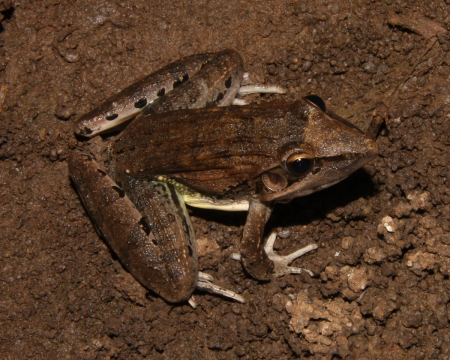FrogMAP — Frog Atlas of Southern Africa
Family Ptychadenidae
Ptychadena anchietae
Plain Grass Frog, Anchieta’s Ridged Frog, Rooirug-graspadda (A)
Species account was published under the name:
Ptychadena anchietae (Bocage, 1867)
Red listing status: Least Concern

Photo by Verburgt L.; Enviro-Insight CC, 2012. URL: FrogMAP: 2038
Distribution
P. anchietae occurs in savanna habitat in all sub-Saharan countries from Angola to Ethiopia in the north, southward to eastern Namibia (Caprivi), eastern Botswana, Zimbabwe and Mozambique (Poynton and Broadley 1985b). In the atlas region, it occurs in the eastern half of North West Province, northern Gauteng, throughout Limpopo Province, northern and eastern Mpumalanga, central and eastern Swaziland and northern and eastern KwaZulu-Natal. It has been recorded as far west as Barberspan (2625DA) and as far south as Gingindlovo (2931BA). There is one atlas record in the northern Free State (2726AD).
This common species has an extended breeding period and is easily detected by its call. The atlas data are relatively complete and reliable.
Habitat
P. anchietae is a widespread inhabitant of the savanna biome in the northeastern part of the atlas region, between 20 and 1450 m a.s.l. It occurs in relatively moist, coastal bushveld vegetation types with a minimum annual rainfall in excess of 600 mm, as well as in more arid habitats such as Mixed Bushveld, which experiences a minimum annual rainfall of 350 mm (Low and Rebelo 1996). Individuals are often found sheltering amongst grass and plant debris on the edges of their breeding sites, which include temporary pans, shallow pools in riverbeds, borrow pits, waterholes, as well as more permanent vleis and dams (Stewart 1967; Jacobsen 1989).
Life history
These frogs are active on the surface throughout the year in areas where standing water is present or the soil is damp. They are able to survive lengthy periods of hot, dry weather by taking shelter to avoid desiccation.
In late winter to early spring, adults begin to congregate around permanent water bodies. At this time, vocalization is restricted to infrequent, quiet, low trills, which differ from the advertisement call (L.R.M. pers. obs.). Breeding choruses develop after the first spring rains, through to late summer or autumn (October–February at Hans Merensky Nature Reserve: L.R.M. pers. obs.). In wet weather, sporadic calling may be heard during the day, but normally commences in the early evening, peaking between 21:00 and 02:00 (Passmore 1978).
Males call from bare or sparsely vegetated areas of the shoreline, usually within 20 cm of the water’s edge. The average distance between calling males is about 80 cm; a distance of less than 20 cm usually elicits a territorial call that results in one of the males moving away from the other (Passmore 1978).
Eggs are laid in shallow water in floating clumps of up to 300, which adhere to vegetation or sink if disturbed. The tadpoles break out of the jelly capsule after 24 hours and develop rapidly (Stewart 1967), undergoing metamorphosis and leaving the water three weeks later (L.R.M. unpubl. data).
The diet includes grasshoppers, crickets, beetles and other insects (Barbour and Loveridge 1928).
Conservation
P. anchietae does not appear to be at risk as much of its habitat is used for game and cattle farming and is relatively undisturbed. The species occurs in a number of provincial nature reserves and national parks.
Current distribution map
 Undated records;
Undated records;  pre-1996;
pre-1996;  1996 to 2002;
1996 to 2002;  2003 to present
2003 to present
Citation:
- Web:
FrogMAP. 2024. Ptychadena anchietae (Bocage, 1867). Animal Demography Unit. Accessed from http://frogmap.adu.org.za/?sp=780; on 2024-04-18 11:04:05. - Book:
Minter L.R., Burger M., Harrison J.A., Braack H.H., Bishop P.J. & Kloepfer D. (eds). 2004. Atlas and Red Data book of the frogs of South Africa, Lesotho and Swaziland. SI/MAB Series no. 9. Smithsonian Institution, Washington, D.C. Published by the Smithsonian Institution and the Avian Demography Unit (now Animal Demography Unit).




